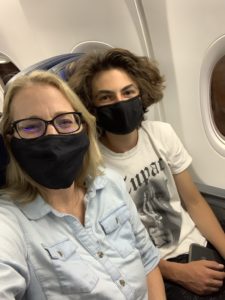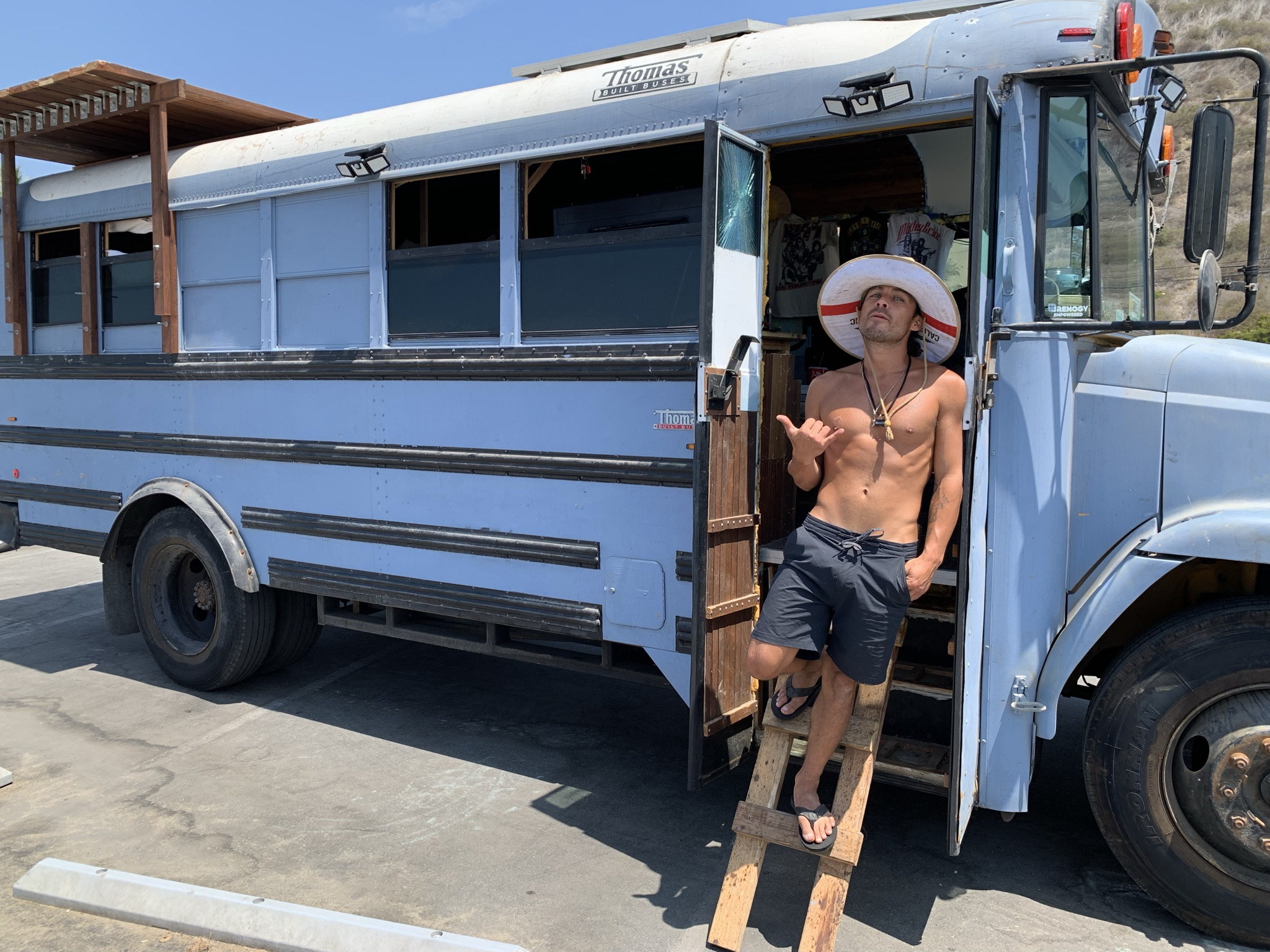The Promise of a Post-Pandemic LA Vacay
Almost unmasking LA before a summer surge sent us packing
I went back to Los Angeles this summer, taking a vacation from my new hometown of Washington, D.C. My second trip to the city since the start of the pandemic started much better than when I visited over spring break, in April 2021. LA had made huge strides toward reopening. Restaurants welcomed diners indoors, attractions and theme parks re-opened, and stores removed mask mandates for the vaccinated. But then that all changed.
How it started, and how it ended
When I arrived in early July, all over LA, there was an aura of optimism, from Hollywood to the beach cities, the populace was eager for a return to pre-pandemic life. Then, a few days before the end of my three-week visit, things took a turn. Just like that, COVID-19 case numbers went up by 60 percent in a single day, and city officials renewed mask orders for indoor public spaces.
After two weeks of feeling a new sense of freedom in the air and sunshine at the end of the tunnel, a stop into the Insomnia cookie shop in WeHo took me aback. As I donned my mask and entered the store, a vigilant employee loudly ordered me outdoors because only one customer was permitted in the store at a time. The tide had turned, again.
Mask, and mask again
Over spring break, masks were still ubiquitous, and tensions remained high between the cautious and the anti-maskers who felt face coverings were unnecessary — or an encroachment on their freedom. As the city readied for July 4rth Independence Day celebrations, it was rare to see a masked face anywhere, except for those behind the register or prepping and serving food, and most businesses had taken down signs regarding masking.
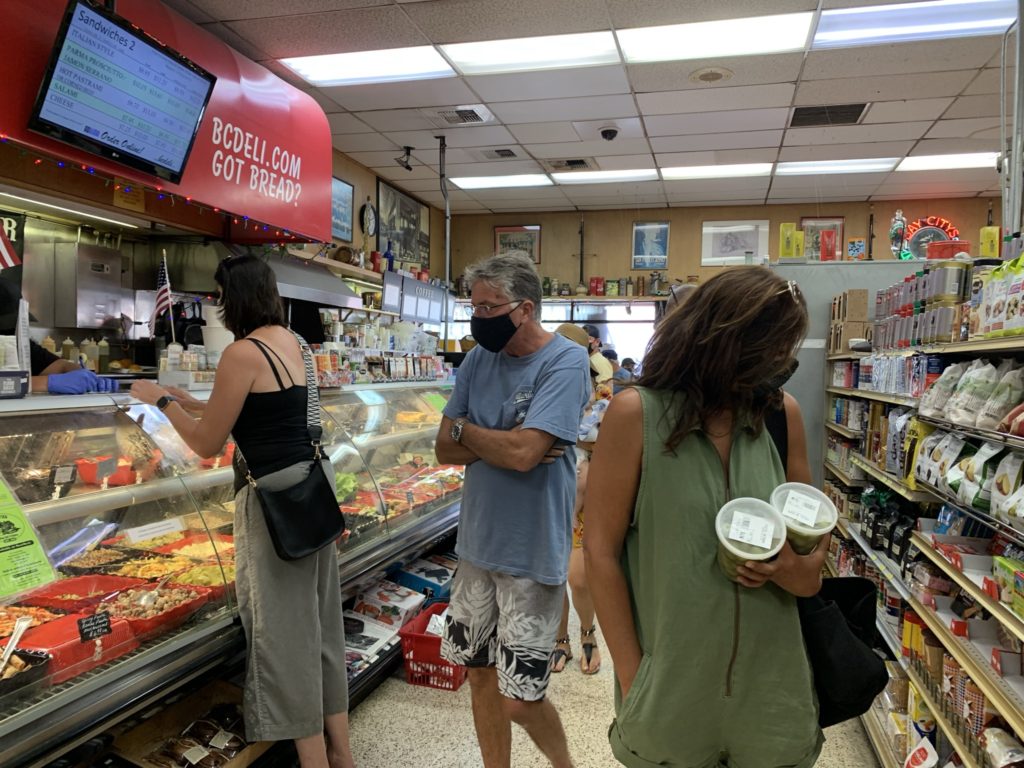
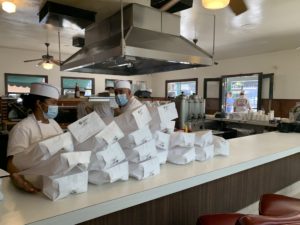
Customers were not allowed inside to eat at the counter at Apple Pan
The only hold outs for masking I visited were the Apple Pan, the historic luncheonette on Pico Blvd., and Bay Cities Deli in Santa Monica, where their vigilant masking enforcers put the Soup Nazi to shame.
Most of the “hygiene theatre” had faded away. At store entrances, gone were attendants whose job it was to politely screen patrons for masks and offer a squirt of hand-sani. While most people maintained some semblance of social distancing, the six-feet directive was six-feet under.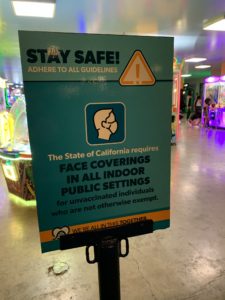
A rare sign of the times, before the renewed masking edict
Nobody puts LA in a corner
At Cinespia, LA’s longest-running outdoor movie event, the July 4rth screening of Dirty Dancing hosted a crowd of more than 2,000 attendees, sitting blanket-to-blanket, across the Hollywood Forever Cemetery lawn. As patrons dined al fresco and grooved to the tunes of the pre-show DJ, they were as high as Baby’s triumphant lift, without a mask or any other reminder of the pandemic in sight. When post-show fireworks exploded, the throngs cheered wildly. It was a true celebration of freedom.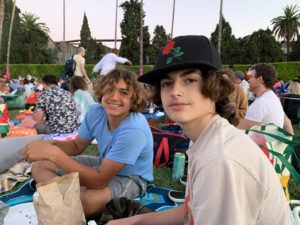
Cinespia picinic before the show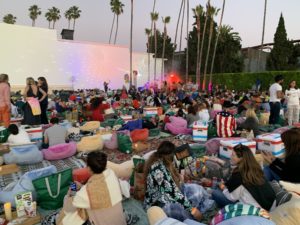
The throngs at Cinespia, a welcome reprieve from social distancing, and masks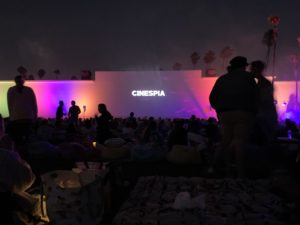
Mingling before “Dirty Dancing” started at Cinespia, like old times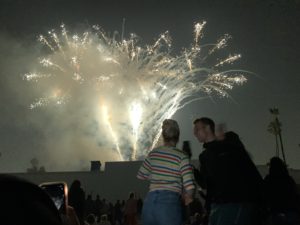
The exhilaration of freedom celebrated with fireworks at the July 4 Cinespia event
At Knott’s Berry Farm, it was child’s play as usual. Despite reservation-only admission, the park seemed as busy as any pre-pandemic summer. Early in the day, patrons wearing masks were sprinkled about, but as the sun rose and temperatures hit 85 degrees, masks came off. Social distancing was almost nonexistent. Picnic tables were more spread apart than usual at eateries, but lines of closely packed-in kids were the norm. Even in indoor settings, such as the in-park restaurants, it was rare to see a mask. The good part was that kids seemed oblivious that there ever was a pandemic, as they squealed with abandon on the thrill rides.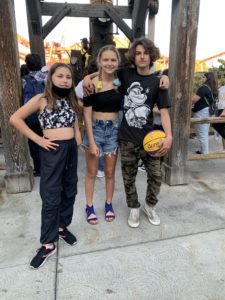 \
\
Cool kids enjoying a sunny day at Knott’s Berry Farm theme park, without a pandemic cloud over their heads
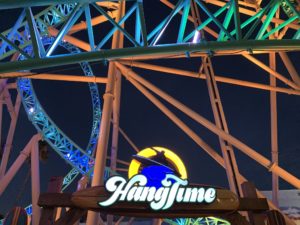
Museums along the Miracle Mile were open, though operating at a reduced crowd capacity. Petersen Automotive Museum offered pre-purchasing of tickets and required an online wellness check and masks for visitors. Los Angeles County Museum of Art (LACMA) also featured reservations-only entry for specified time blocks plus on-site wellness screenings and temperature checks before entry for indoor exhibits. Outdoor public art exhibits, such as the Urban Light lamppost field, and dining at the Resnick Pavilion were free and open.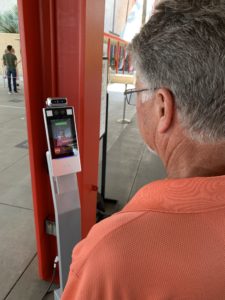
Checking temperature at LACMA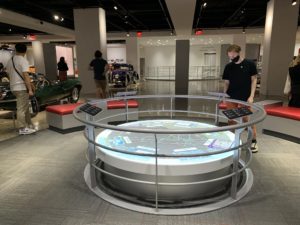
Mask required at Petersen Museum
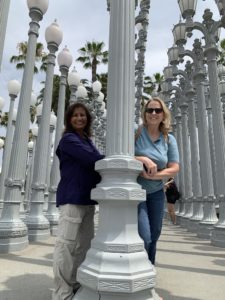
Social distancing but mask-free at the outdoor public art “Urban Light” installation at LACMA
Pandemic after-party
Nightlife continued to pick up where it left off when lockdowns started in March 2020. Cooped up for nearly a year and half, clubbers were out in droves. In West Hollywood, the world’s most famous gay bar, The Abbey, was crammed with people, though there were slightly fewer tables than usual, spread out on its expansive patio.
In Hollywood, with COVID case numbers falling midway through the summer, The Hollywood Partnership (THP), an organization dedicated to promoting patronage of the district center, ramped up its efforts to attract more visitors.
“By all accounts, domestic tourism is thriving,” said Kristopher Larson, President and CEO of THP. “Hotel occupancy is back into the 60th percentile, a figure which already exceeds previous recovery projections for the year. We’re also seeing continued growth in pedestrian vibrancy on the Walk of Fame, and our pedestrian counts through June 30 have already reached levels comparable to fall and winter of 2019 pre-pandemic.”
Many Hollywood establishments, like The Dudes’ Brewing Company, did their part to help revive the strip by appealing to its lifeblood of tourists the good old-fashioned way: great happy hour prices for drinks and food, along with offering expansive fresh-air patio seating. Art Paz, a Dudes’ manager, also doubled down on providing attentive customer service, despite the fact that most restaurants remain understaffed due to many service workers staying home during the pandemic. “Good drinks, good food and good service will keep them coming back,” said Paz.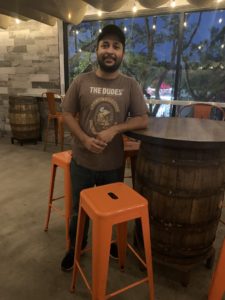
Hanging with Gus the manager at the Dudes’ Brewing Company llywood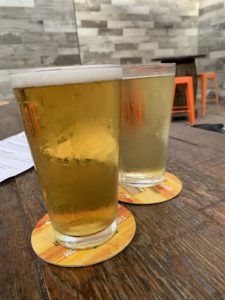
Happy Hours made happy again, with spaced-out outdoor seating at Dudes’
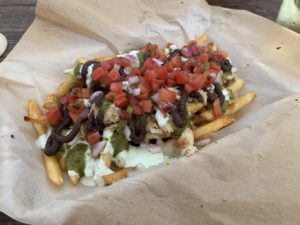
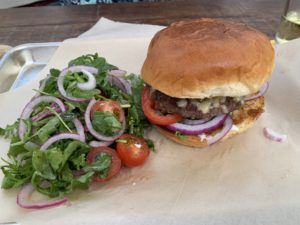
Sheltering space
Starting early in the summer season, tourist draws like Marina del Rey were flourishing. The newly renovated Marriott Courtyard Hotel on the harbor welcomed a steady flow of guests through July, and its upscale waterfront eatery, Brizo Bar & Restaurant, was fully committed nightly, requiring reservations at least 24 hours in advance. Like many of the properties across LA that saw a precipitous drop in clientele during the pandemic’s worst surges, the hotel took the opportunity to remodel as well as revamp its offerings, including expanding its outdoor dining and contactless mobile room-service, enhanced cleaning protocols, reservations for the pool, and 24-hour turnarounds on rooms.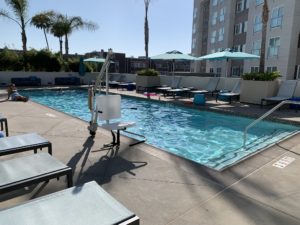
An empty pool at Marriott Courtyard Inn in Marina Del Rey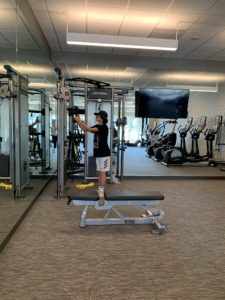
The gym to ourselves at the hotel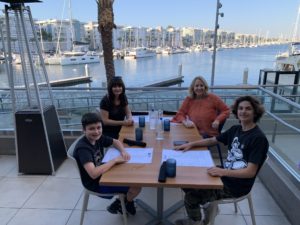
Lucky to get a reservation at Brizo, overlooking the Marina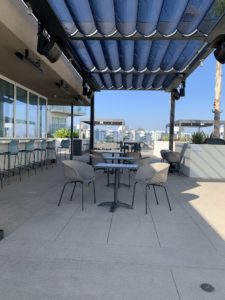
Lots of open space around the hotel grounds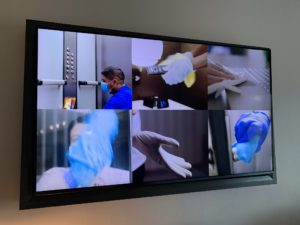
The deep cleaning procedures showcase on the hotel’s private channel
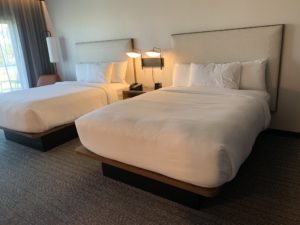
Enhanced cleaning throughout the hotel is intended to help pandemic-stressed guests sleep well at night
Glossing over deep cleaning
If the sparsity of available accommodations in July was any indication, tourism was on track to surpass pre-pandemic occupancy levels. Hotels across LA maintained premium season pricing, and even reasonably priced Airbnb places were rare to find, partly because many hosts who bought investment properties were driven out of business when COVID hit, and guests cancelled in droves.
For our family’s extended stay, I opted for a no-frills two-bedroom, two-bath Airbnb rental in Beverly Hills for $250 per night. But despite promises of “deep cleaning,” the wipe up after the last guest was cursory at best. Even if there were no pandemic, I would’ve appreciated a quick sweep under the bed, which would have netted a previous guest’s credit card along with medical papers indicating the person was being treated with antibiotics.
Boom or bust
No one needs to tell anyone in LA, whether they are a tourist or a full-time resident, about the high cost of housing there. While many Californians are suffering the economic impacts of COVID-19, wealthy buyers have capitalized on low interest rates, driving elevated prices even higher. In September 2020, California’s median home price reached $712,430 — outpricing homes for working families.
This fact hit home when I took a trip down memory lane to my old residence in South Carthay from which I moved five years ago. I met the new owner of my duplex, a 29-year-old retired adult film actress. She was one of the lucky ones who bought early in 2020, landing a deal of $1.6 million for my former 4,000 sq.-foot duplex, complete with a pool and four-car garage. In today’s market, it would be at least $2 million. Ridiculous home prices have driven people onto the streets and are the reason many Airbnb hosts don’t give a darn about meticulous housekeeping, because rentals right now in LA can demand a premium price without grand offerings.
The mean streets of LA
One major visible consequence of COVID-19 remains the tent towns of homeless people, who have encamped along highways, beaches and the even borders of some of LA’s most affluent neighborhoods. With the lifting of eviction bans expected at the end of summer, putting more people out of their homes, surely these homeless camps would have grown, but due to Biden’s recent stay on the ban, this explosion of homelessness may be abetted a while. For now, LA has adapted to their new living situation, such as when I got directions from a seller on Craigslist who advised, “You can park beside the building, next to the homeless camp.”
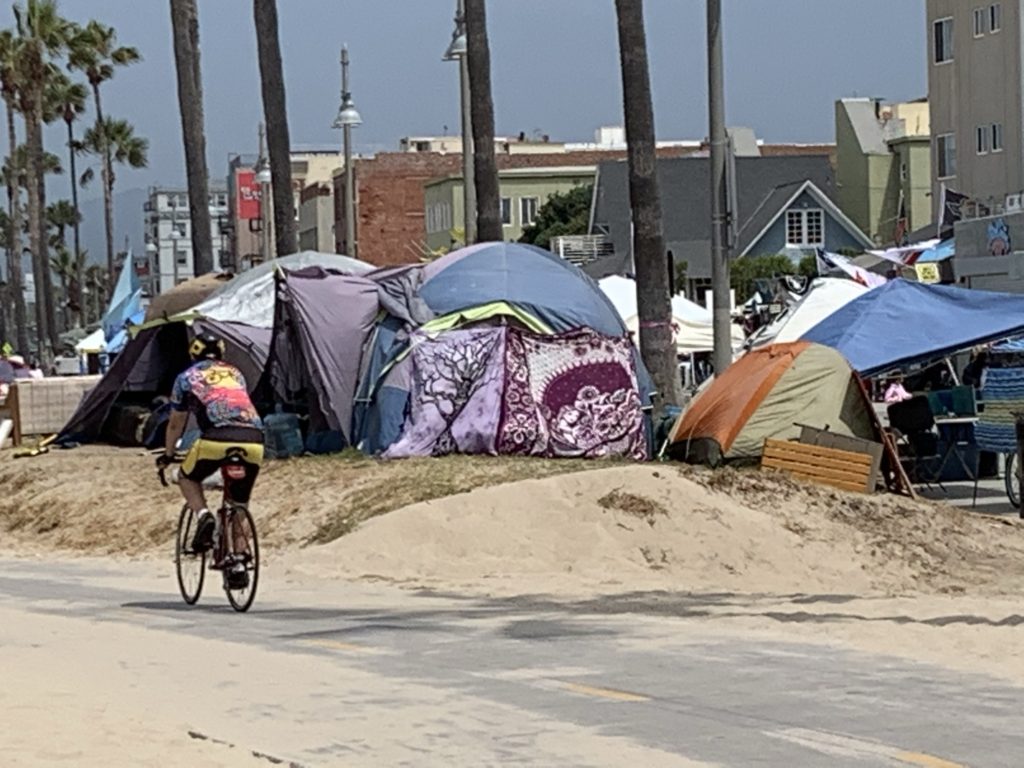
Tent cities along the beach and acorss LA highlight a depending housing crisis
Social distancing disorder
While they may be a few feet farther apart, people are once again all up in other people’s faces in LA. After an 18-month hiatus from normal socializing, it’s no wonder people have forgotten their manners. Servers at restaurants, where a labor shortage has impacted their ability to properly service customers, told me that patrons have become more demanding and have less patience for slow service, ironically blaming those who are working – and not those sitting out the pandemic and collecting unemployment.
A usually decorous friend who lives in West Hollywood told me she was shushed twice in one week, at a hair salon and then at a nail salon, because her voice was disturbing others. She surmises either she has forgotten how to use her indoor voice after many months of quarantining, or other people have become less tolerant. From my own observations and experience, it seems to be a little of both, not just for her but for many of us.
Traffic signs
Indeed, both the good and the bad of LA have re-emerged post pandemic. Traffic has returned across the city. While I enjoyed quicker travel times over spring break, it was exciting to see the activity on the roads again, including an only-in-LA experience of being caught in the middle of a literal Ford-versus-Ferrari drag race on the 405 when a Mustang and an 812 GTS blew past my Lincoln Nautilus at a minimum of 100 miles an hour.
One drive I have always loved in LA is along the Pacific Coast Highway to Malibu. On a quiet Monday night, I cruised up the coast to see how my old favorite hot spots had weathered the pandemic. As I turned onto PCH in Santa Monica, an overhead sign flashed a warning to any covidiots still undecided about what they should do if they wanted to get to the end of the pandemic. It read, “This Is A Sign to Get Vaccinated.”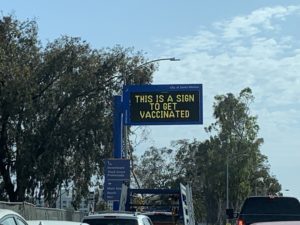
A sign to help those who are lost find the way out of the pandemic
On a Monday night in Malibu, the Gladstone’s crowd was not applauding the sunset like they had done for 44 years, because the restaurant was closed up tight – a casualty of the pandemic, but other hotspots like Moonshadows, Geoffrey’s, Dukes, Malibu Seafood and our ultimate destination, Paradise Cove, were hopping, proving that you cannot keep a determined tourist down and out, in Beverly Hills, or the beach cities.
Masks are the new black
Midway through my visit, Mayor Eric Garcetti called for people to mask up again indoors. With the revived orders, the rancor of the arguments about them resuscitated, casting a pall on LA once again. But while LA was the first, they were not the last to call for a reshowing of face coverings. In the weeks to follow, one by one, as the Delta variant surged, cities and states asked people to once again mask up indoors, vaccinated or not, based on their area’s incidence of COVID-19 cases.
Ebb and flow
With a wave of new COVID cases sweeping across the city, there was a sudden and sad turnabout in the lightness and liberty that I had experienced during the first part of my visit.
Perhaps as a cosmic analogy to the changing tides in hopes, a massive dump of 17,000,000 gallons of raw sewage off the shore of El Segundo closed down the beaches for the rest of our trip. It was too stinky to even get out of the car at the Blue Butterfly Preserve, which we hoped to visit on our way to LAX.
As our plane soared over the ocean, I looked longingly at the City of Angels beneath us, with great optimism, on a wing and a prayer, that our next trip back in a few months will be maskless, carefree, and coronavirus free.
